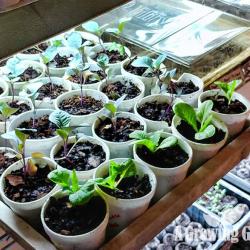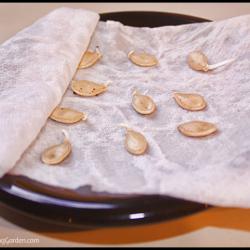
I Love Coco Coir ... and So Do Seeds!
I used to start my seeds in peat or a peat blend, but for the last few years have been starting seeds exclusively in coconut coir (pronounced 'kwar') and it has made a world of difference!
Coconut Coir (also known as Coco Coir) is made from coconut husks. It's relatively inexpensive (especially compared to prepackaged "seed starting blends"), readily renewable, and environmentally friendly. And, in my experience, seeds grow really well in it!
I mean REALLY, REALLY, REALLY well.
Apparently, one of the main reasons that seeds grow so well in coconut coir is because the fiber can hold about 9 times it's weight in water, but it also allows air to pass through it freely. So, the coco coir stores lots of water without getting soggy ... it's fluffy and light even when it's wet. And seeds like that, or so it seems.
I'm sure there must be a lot of different brands of coconut coir available for seed starting, but the only brand I've been able to find locally here in our little town is Burpee's. So, I've only ever used the Burpee Concentrated Coconut Fiber Seed Starting Mix. It comes in concentrated "blocks" and you just have to add water to the blocks to create the planting medium.
I must admit that I was first drawn to the fact that these come in small, compressed blocks which are super easy to store and are a BIG space savers for anyone growing a lot from seed indoors. But then, after reading more about the benefits of starting seeds in coconut fiber, I was intrigued enough to try it ... now I'm hooked. I've found that all sizes and types of seeds grow well in the coconut fiber -- from very small seeds to very large seeds. I've also not had any sort of problem with algae growing on or attracting fungus gnats with the coconut growing medium. I definitely had those problems with peat. Yuck!
The Steps I Take to Start Seeds in Coconut Fiber
1. OK, this is pretty obvious, but you'll need to get yourself some coconut coir. Again, I've been using Burpee's brand, but I imagine there are many other brands that work the same or similar way. A single block of Burpee's coconut coir cost me $2.95 (purchased at my local Southern States) and makes 8 quarts of seed starting mix -- enough to fill multiple seed trays.

2. Unwrap the blocks from their packaging and place into a large bucket or container. I use a pretty big, old metal bucket -- it just fits into my sink and there is plenty of extra room for mixing.

3. Add water. You'll need to follow the instructions for whatever brand you end up using, but Burpee's calls for 4 1/2 quarts of water per coconut block. I just pour warm water on top of the blocks and let it sit for about 5 minutes. After a few minutes, the blocks will have absorbed the water and will start to crumble and fall apart. Using your hands, mix everything up. Add more water if needed to make sure all of the coconut coir is wet and has fully expanded. The mix will be very fluffy.

4. Add the mixture to seed starting trays, cell packs, or whatever container you are using and plant your seeds at the required depth (check the seed packet for instructions for depth and spacing). And that's it!
It might be a bit tricky to tell when the medium is dry, so you'll need to keep an eye on things to be sure not to let the coir dry out, but otherwise, it'll be just like growing seeds in any other type of soilless mix.
















Join the Conversation!
February 20, 2014
I still like my own mix of peat& soil, I feel coir dries too quickly.
Reply
February 20, 2014
Do you ever have problems with algae? That was my main problem with peat... it got awfully slimy!